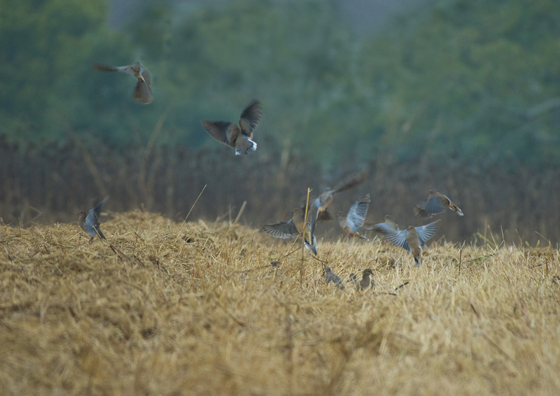By Lee McClellan
FRANKFORT, Ky. – The crisp early morning and earlier nightfall remind Kentuckians that fall isn’t far away. The smell of gunpowder, the clunking of spent shotshells in a vest and dove breasts wrapped in bacon and grilled aren’t far away either. It is a hunter’s favorite time of year.

Dove season opens statewide Sat., Sept. 1. Although brown, crunchy moisture-free grass and cracked brick ground cover large swaths of Kentucky, the drought won’t ruin the dove opener.
“There are plenty of doves around Kentucky,” said Rocky Pritchert, migratory bird coordinator for the Kentucky Department of Fish and Wildlife Resources. “It’s a mixed bag. Some dove fields are looking good while some were affected by the drought.”
The Purchase Region is the area of Kentucky hardest hit by drought, but dove field conditions, contrary to what common sense dictates, are in huntable shape.
“As far as the dove fields in our region, they got off to a slow start and the plants stunted a little,” said Tony Black, Purchase Region wildlife regional coordinator for Kentucky Fish and Wildlife. “The sunflower and millet still headed out with pretty decent seed content in them. It is not too bad considering how dry we’ve been. On average, the counties in our region are 12 to 13 inches below normal rainfall for the year.”
Hunters who put in a little time scouting before hunting a particular field place themselves at an advantage. “Pull out the dove hunting guide and go and look at the public fields before you hunt them,” Pritchert said. “If you plan to hunt a private field or your traditional dove spot, you still must scout this year. You still need to see if an area holds any birds.”
The field you plan hunting could be laden with doves on opening day. If you don’t pick a good spot in that field, however, your hunting vest may weigh less at the end of the day than at the beginning because you’ve spent your shotshells and have few doves.
“The first thing I look for when setting up in a dove field is a dead tree or snag,” Pritchert said. “Then, I look for the flight patterns of the doves. Survey where they enter the field and where they exit. Find the entry spot and set up near there. It is better to find a place where they enter the field than where they exit.”
Doves often fly into a field through gaps in trees or a swale in the ground.
“A dead tree that is in one of these flight patterns is a great spot,” Pritchert said. “They often land in dead trees before entering the field to feed.”
Doves also use power lines for the same purpose. Studying these features and setting up near them makes for a much more eventful day. A poorly chosen spot in a good field leads to frustration when others down all of the doves. It is like watching someone from the opposite end of the boat catch all of the fish. Study and choose wisely.
Hunters also need to think on their feet and adjust after opening day this year because of the dry weather.
Black recently witnessed farmers cutting silage and harvesting corn in the Purchase region. Pritchert observed the same in the Bluegrass Region.
“I’m beginning to see silage cut here in central Kentucky,” Pritchert explained. “It is a little earlier than usual because of the early spring and drought. Doves will likely scatter from a hunted field more quickly this year because there are too many other food options for them.”
This year, flexibility in choosing your dove hunting areas after opening weekend extends your hunting season.
“I hunt doves where I can find them,” Pritchert said. “I’ll hunt silage fields and fallow fields covered in foxtail.”
Hunters can also stretch the dove season by quitting earlier in the day.
“Landowners who have those longer dove shoots well into the season manage the shooting pressure on their fields,” Pritchert said. “Keep the pressure down at the beginning of the season. Skip a week between shoots and get out of the field earlier in the day, by 6 p.m. at the latest. The more time in the evening the doves have to feed undisturbed, the better.”
Pritchert also warned those hunting with dogs must realize they overheat easily in early September. “Watch your dog closely and give them plenty of water and rest,” he said. “This is one of the most dangerous times for dogs for heat stroke.”
Wear drab clothing while dove hunting. Camouflage clothing is best, but tans and greens also work. Avoid white tee shirts and loudly colored shorts.
The first segment of the dove season closes Oct. 24. The second segment runs from Nov. 22 through Nov. 30, while the third segment of the season opens Dec. 29, 2012 and closes Jan. 4, 2013.
“Those late season hunts can be really good,” Black said. “You have those northern migrating birds coming down. You can walk them up just like quail in a corn field and have some good hunting.”
The daily limit is 15 doves.
Author Lee McClellan is an award-winning associate editor for Kentucky Afield magazine, the official publication of the Kentucky Department of Fish and Wildlife Resources. He is a life-long hunter and angler, with a passion for smallmouth bass fishing.
-30-
The Kentucky Department of Fish and Wildlife Resources manages, regulates, enforces and promotes responsible use of all fish and wildlife species, their habitats, public wildlife areas and waterways for the benefit of those resources and for public enjoyment. Kentucky Fish and Wildlife is an agency of the Tourism, Arts and Heritage Cabinet. For more information on the department, visit our website at fw.ky.gov.


Be the first to comment